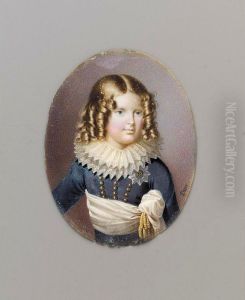Nicolas Francois Dun Paintings
Nicolas Francois Dun, born in 1733, was a French artist and engraver whose life and work spanned the late Baroque and early Neoclassical periods, reflecting the transitional aesthetics and evolving tastes of his time. Dun's artistic journey began in an era dominated by the lavishness of the Rococo style, yet his work increasingly embodied the clarity, simplicity, and classical themes that would hallmark Neoclassicism. His contributions, although not as widely recognized as those of his contemporaries, played a significant role in the artistic movements of 18th-century France.
Dun's early life was marked by rigorous training in the arts, studying under established engravers and painters of his era. This foundational period was crucial, as it equipped him with a diverse skill set and an appreciation for both the technical and thematic elements of art. Throughout his career, Dun exhibited a keen interest in the human form, mythology, and historical subjects, which were prevalent themes of the time. His engravings and paintings often depicted scenes from ancient history and mythology, rendered with an attention to detail and an emphasis on emotional depth and moral complexity.
As France edged closer to the upheavals of the late 18th century, Dun's work reflected the shifting political and social landscapes. The Enlightenment, with its emphasis on reason, science, and individual liberty, influenced artists and intellectuals alike, and Dun's art was no exception. He began to incorporate Enlightenment ideals into his work, using art as a medium to explore and comment on the human condition, societal norms, and the quest for knowledge.
Despite the rich body of work he created, Nicolas Francois Dun's legacy is somewhat overshadowed by the luminaries of his time, such as Jacques-Louis David, the leading figure of Neoclassicism. However, Dun's contributions to French art should not be underestimated. His engravings and paintings offer valuable insights into the transition from Rococo to Neoclassicism, embodying the tension between ornate decoration and classical simplicity, between the old regime and new philosophical horizons.
Nicolas Francois Dun passed away in 1831, leaving behind a legacy that, while perhaps not as celebrated as that of his counterparts, is emblematic of a pivotal period in art history. His work remains a testament to the richness and diversity of French art during one of its most transformative epochs. Through his engravings and paintings, Dun continues to speak to the complexities of his time, offering a window into the past for historians, art enthusiasts, and casual observers alike.
